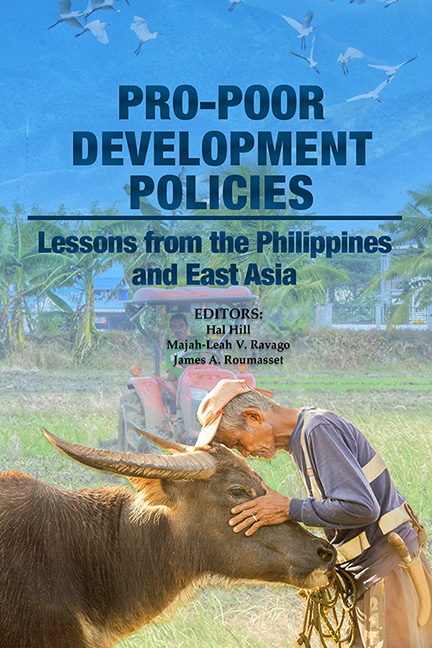Book contents
- Frontmatter
- Dedication
- Contents
- Figures, Tables and Boxes
- Foreword
- Foreword
- Message
- Preface and Acknowledgements
- About the Editors
- About the Contributors
- Acronyms
- Part 1 Introduction and Synthesis
- Part 2 Agricultural and Economic Development
- Part 3 Economic Policies for Achieving Targeted Levels of Living in the Philippines
- Part 4 Inequality and Economic Development
- Part 5 Competition Law and Policy
- Part 6 International Dimensions
- Index
7 - The Political Economy of Rice Policy in the Philippines
Published online by Cambridge University Press: 09 January 2024
- Frontmatter
- Dedication
- Contents
- Figures, Tables and Boxes
- Foreword
- Foreword
- Message
- Preface and Acknowledgements
- About the Editors
- About the Contributors
- Acronyms
- Part 1 Introduction and Synthesis
- Part 2 Agricultural and Economic Development
- Part 3 Economic Policies for Achieving Targeted Levels of Living in the Philippines
- Part 4 Inequality and Economic Development
- Part 5 Competition Law and Policy
- Part 6 International Dimensions
- Index
Summary
The Philippines has a long history of efforts to improve its performance in agricultural productivity and food security. Its record has been always described as poor, with little progress in reducing hunger incidence and increasing productivity and competitiveness. A long-standing strategy of pursuing self-sufficiency in rice production, coupled with trade protection, not only failed to foster sustainable food security but also hindered the growth of agriculture competitiveness even as world trade has become much more globalized.
The pressure to reform had been a continuing challenge, demanded by economic efficiency but sensitive to evolving political contexts. Reforming the rice sector also increasingly became an international concern, especially among rice-trading countries, as the country’s failed strategy resulted in ever-growing imports of rice. Trade disciplines that the country subscribed to under agreements with the World Trade Organization (WTO) and Association of South East Asian Nations (ASEAN) provided added reform pressures and complications.
On 14 February 2019, the Philippines finally drastically changed its strategy for food security when it enacted Republic Act 11203, “An Act Liberalizing the Importation, Exportation and Trading of Rice, Lifting for the Purpose the Quantitative Import Restriction on Rice, and for Other Purposes”. The Act deregulates rice, liberalizing importation and scrapping quantitative restrictions (QRs) on imports in favour of tariffs. It also eliminates the regulatory functions of the National Food Authority (NFA), constraining the agency to focus on buffer stocking only.
The passage of RA 11203 came about after more than 35 years of economic analysis, reform advocacy and political-economy calculus. Earlier efforts were met with challenges, not the least of which was the fluidity of governance, exacerbated by the lack of organized constituency for and the resistance of strong interests against reform. It took a rare confluence of events, circumstances and unusual alliances to finally see the reform through—a food security “crisis” that could not be addressed by the existing regulatory and institutional framework, the influence of reform-oriented technocrats backed up by good analysis, and a strong president who listened to his economic team.
This paper reviews the experience of the Philippines in reforming the rice industry and examines aspects of political governance that have frustrated and may continue to hinder rapid progress in the reform efforts.
- Type
- Chapter
- Information
- Pro-poor Development PoliciesLessons from the Philippines and East Asia, pp. 157 - 189Publisher: ISEAS–Yusof Ishak InstitutePrint publication year: 2022

